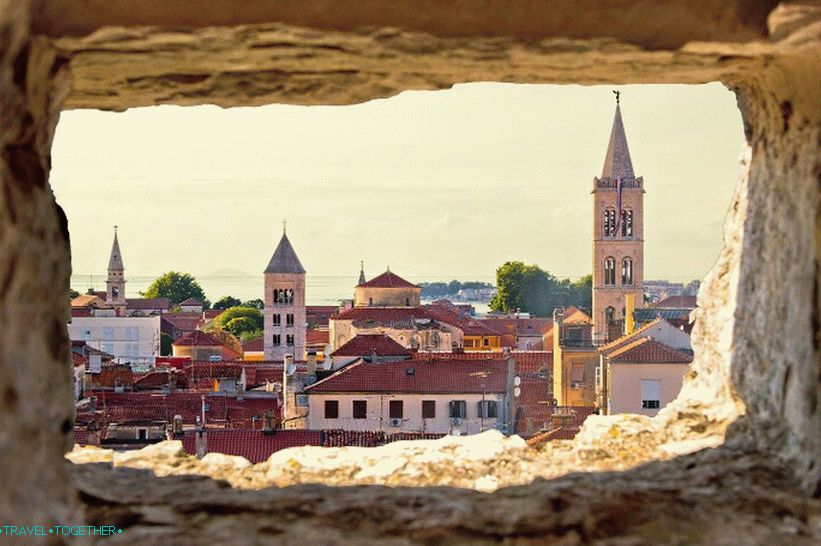Trogir (Croatia) – the most detailed information about the city with photos. The main attractions of Trogir with a description, guides and cards.
Contents
City Trogir (Croatia)
Trogir is a city in the south of Croatia in the Dalmatia region. Situated on coast of the Castellan Bay in the Central Adriatic between Split and Šibenik cities. Trogir is a small ancient city the medieval historic center of which is one of the most well preserved in Europe and included in the list of objects UNESCO World Heritage Site. Old town of Trogir, rich cultural and historical monuments, authentic architecture and a maze of charming streets located on a small island and called “Little Venice”. It is a great place to stay for a day. trips from Split, which is not like other South cities Croatia
- Geography and climate
- Best time to visit
- Practical information
- Story
- How to get there
- Food and drink
- sights
- Video
- Maps and guides
- Comments and reviews
Geography and climate
Trogir is located in the south of Croatia on the shores of Kashtelansky the gulf. The city is located 27 km north-west of Split and 61 km south of Sibenik. The climate is Mediterranean subtropical. Summer in Trogire is hot and dry. Winters are mild and wet.
 Old panorama cities
Old panorama cities
Best time to visit
For a beach holiday, the best time will be June – September. Although the swimming season starts in May and lasts up to September The sea warms up in the summer to 24-26 ° C.
 View of the old Trogir
View of the old Trogir
Practical information
- The population is over 13 thousand people.
- The area is 35 square kilometers.
- The language is Croatian.
- Currency – Kuna.
- Visa – Schengen.
- Time – Central European UTC +1, in summer +2.
Story
Trogir is an ancient city. It was founded by the Greeks in the 3rd century before our era. The settlement was called Tragurion. With the arrival of the Romans Trogir was in the shadow of rich Split (Salons). In the 7th century the city entered The composition of the Croatian Kingdom.
In the 12th century, Trogir was almost completely destroyed by the Saracens. The city quickly went from wounds and in the 13th century was one of most prosperous cities of Dalmatia. In the future, the fate of Trogir repeated the fate of this part of the Croatian land.
 Evening Trogir
Evening Trogir
In 1420 the city became part of the Republic of Venice, in 1797 year – the Habsburg Empire. After World War I, Trogir entered into the kingdom of Serbs, Croats and Slovenes (the future Yugoslavia). During the Second World War, the city was occupied Italy After the war, he returned to Croatia, which until 1991 was part of Yugoslavia.
How to get there
Trogir is located in close proximity to the airport Split (about 3-5 km). From the airport to the city can be reached by bus 37 or taxi. The bus station is located on the outskirts historic center and has regular communication with Dubrovnik, Zagreb and Zadar.
 View of the old city
View of the old city
Food and drink
Traditional dishes of Trogir, as in most of the kitchen Dalmatia include various seafood: fried fish, mussels, scampies, risotto, salted sardines, and roasted lamb, beef in tomato sauce, pasta. Other important ingredients are pršut (ham), olive oil, sheep cheese, wine.
 Trogir
Trogir
sights
Trogir – the pearl of Dalmatia, the main attraction which is a charming old town. Historical Center quite small and located on an island between the mainland and another island Ciovo. With the continental part of the medieval core of Trogir It is connected by a stone bridge, with Čiovo – a drawbridge. Despite, that the area of the old town is quite small, here is many historical and cultural monuments: ancient churches, medieval city fortifications, ancient buildings.
 Old city
Old city
The historical center of Trogir is a unique the combination of Romanesque, Baroque and Renaissance architecture with a labyrinth of atmospheric streets that intersect at the most unexpected places. All this makes it so unlike others. city of Dalmatia. The city is surrounded by lush vegetation, islands, rocky and sandy beaches, of which the most famous are the beaches of Pantan and Slatina.
Central Dalmatia is a picturesque coastline with stunning beaches, spectacular lavender-covered islands hills, small medieval and renaissance cities, ancient roman ruins. Trogir is one of the most picturesque cities of this region. On both sides of it excellent beaches with clean and warm sea.
 Streets of Trogir
Streets of Trogir
In the 12th century, Trogir was destroyed by the Saracens and rebuilt. AT The 13-15th century historical core was surrounded by walls and towers. Before of our time, there are two towers of the 13th century and fragments of powerful medieval fortifications (from the north and west side). The central entrance to the old city was the North Gate, built in 1665 in the Baroque style. Installed on them 15th century gothic sculpture dedicated to st. John Trogir (Giovanni Orsini) – the patron of Trogir.
 North Gate
North Gate
The fortress of Kamerlengo – the medieval fort of the 15th century, located in the western part of the historic center practically on the waterfront. The fortress was built to protect Kashtelansky the gulf.
 Fortress Camerlengo
Fortress Camerlengo
The main square is the center of the medieval core of Trogir. Square has an amazing concentration of interesting sights: Palace of princes (13th century), town hall (15th century), cathedral of sv. Lawrence (13-15 century), the clock tower (part of the Church of St. Sebastian 15th century), Romanesque church of sv. John the Baptist (13th century), church St. Mary and the church of sv. Barbarians.
 Main square
Main square
Church of sv. Lawrence – Cathedral, one of the most Croatia’s beautiful religious buildings and the largest building Trogir. The church was built on the site of a more ancient sacral structures destroyed by the Saracens in the 12th century. Its construction lasted for 3 centuries. Therefore, the temple combines Immediately Romanesque, Baroque and Renaissance architecture. Interesting Features: Ancient Romanesque door of the 13th century, surrounded by stone Lions, 47 meter high gothic Venetian bell tower and Mannerism (Campanile), a 15th century baptistery carved in wood choirs, beautiful sacristy, chapel of st. John with the beautiful by pictures.
 Cathedral of sv. Lawrence
Cathedral of sv. Lawrence
The clock tower is one of the symbols of Trogir, an ancient tower with a bright clockwork. Once was part of the church of St.. Sebastian 15th century. Nearby is the city loggia with beautiful columns and reliefs. The stone statue on the tower is called Justice and dates from the year 1471.
 Clock tower
Clock tower
Church of sv. Petra is a small gothic church that was once part of a Benedictine monastery. It is believed that The building was built in the 14th century. The church has a simple facade and rich interior with works of Molinari and Lazzarini, 17th century sculptures.

Dominican monastery was founded in the 13th century. Church was built in the 14th century. Here are stored many important works of art and religious relics. Interest represent the triumphal arch and wooden altar, as well as a number of old tombs
 Dominican monastery
Dominican monastery
Church of sv. John the Baptist – a simple single nave romance a building built in the 13th century by master Radovan on the site of more early Christian religious building destroyed Saracens. This medieval church belonged to the male Benedictine monastery.
 Church of sv. John the baptist
Church of sv. John the baptist
Palace Chipiko – an ancient building in the Gothic style, which was built in the 15th century for the aristocratic family of the same name on the foundation of several Romanesque houses. One of the most interesting features of the building is a carved window in the Venetian style Alesi’s work. A wooden statue is installed at the main entrance. a rooster that was captured from a Turkish vessel by a member Chipiko family in the middle of the 15th century during a naval battle.
 Chipiko Palace
Chipiko Palace
Benedictine monastery of sv. Nicholas was founded in the 11th century and located on the waterfront of Trogir. The bell tower was added at 16 century. The monastery has a magnificent interior that was completely changed to baroque in the 18th century. Of the many works the arts that are stored here are the most noticeable works by Antonio Zanchi, Paolo Veneziano and Nicola Grassi, as well as Madonna and Child of the 13th century.
 Benedictine monastery
Benedictine monastery
Trogir has magnificent promenades with magnificent views of the bay and old town. This is a great place for evening walks with many restaurants and cafes.
 Embankment Trogir
Embankment Trogir
Video
Maps and guides
City map






